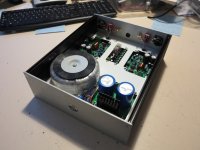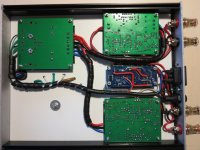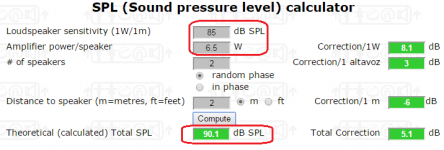Step by step
Thank you.
Basically I hear music at near field. My first equipment is kidnapped by the televisor and the family.
I want quality, without noise (I have more noise at mains, and continous).
I have already taken the first step. I just ordered a DC blocking "turbo" (turbo: two PCB in series) with one IEC and two schuko (one for the AV Marantz SR4500 and other for the new system mod86?, sharing KEF Q100 and ODAC).
Step by step / Paso a paso.
Thank you.
Basically I hear music at near field. My first equipment is kidnapped by the televisor and the family.
I want quality, without noise (I have more noise at mains, and continous).
I have already taken the first step. I just ordered a DC blocking "turbo" (turbo: two PCB in series) with one IEC and two schuko (one for the AV Marantz SR4500 and other for the new system mod86?, sharing KEF Q100 and ODAC).
Step by step / Paso a paso.
Last edited:
What's your desired SPL? How loud do you normally listen when you really crank it? Measure with an SPL meter (or app) as suggested already, then do the math. You can find the math on my website: LM3886 chip power amplifier thermal design.
~Tom
~Tom
In the near-field you will have ample power with the standard build of Modulus 86 and then some. Those are typical sensitivity small bookshelf speakers. Most of the music you listen to will be in the first watt. You will probably be using 1-4 watts most of the time. 10 watts will be loud, 22 watts will give you considerable headroom for seriously loud sound.
So you could build the amplifier with transformers with 18v secondaries instead of 22v ones and still have ample power.
38 watts will give you a small amount of additional headroom for using them in a bigger room if you ever get the opportunity. So I suggest you build it as standard if you can get transformers with 22v secondaries for same price.
I am building this for my Dad with one stereo chassis for a small room. Cables runs will be fairly short (small room) and the amplifier can be sitting on a shelf off the floor.
You want quality without noise, you should get it with ease and plenty of headroom.
Using Monoblocks (double mono) you could position the amplifiers much closer to the loudspeakers and run cables that are under a meter instead of several meters. However you would need long interconnects and power cables going to the amplifiers. The amplifier would still be driving a passive crossover though (albeit a very simple one in the case of the Q100's). You would probably want to switch them on together at the mains switch rather than stooping on the floor.
In practice I doubt there would be any kind of audible difference between them. You should not be suffering any issues with stereo crosstalk with this amplifier.
So you could build the amplifier with transformers with 18v secondaries instead of 22v ones and still have ample power.
38 watts will give you a small amount of additional headroom for using them in a bigger room if you ever get the opportunity. So I suggest you build it as standard if you can get transformers with 22v secondaries for same price.
I am building this for my Dad with one stereo chassis for a small room. Cables runs will be fairly short (small room) and the amplifier can be sitting on a shelf off the floor.
You want quality without noise, you should get it with ease and plenty of headroom.
Using Monoblocks (double mono) you could position the amplifiers much closer to the loudspeakers and run cables that are under a meter instead of several meters. However you would need long interconnects and power cables going to the amplifiers. The amplifier would still be driving a passive crossover though (albeit a very simple one in the case of the Q100's). You would probably want to switch them on together at the mains switch rather than stooping on the floor.
In practice I doubt there would be any kind of audible difference between them. You should not be suffering any issues with stereo crosstalk with this amplifier.
Android
Sonómetro : Sound Meter
-> https://play.google.com/store/apps/details?id=kr.sira.sound

Eagles - Hotel California (CSM) (1976) (Vinyl, *******) {24-96} [FLAC]
Playing loud
Near field
Two meters to left speaker
Sonómetro : Sound Meter
-> https://play.google.com/store/apps/details?id=kr.sira.sound
Eagles - Hotel California (CSM) (1976) (Vinyl, *******) {24-96} [FLAC]
02. New Kid In Townfoobar2000 1.3.8 beta 1 / Dynamic Range Meter 1.1.1
log date: 2015-03-18 23:26:09
--------------------------------------------------------------------------------
Analyzed: Eagles / Hotel California (CSM)
--------------------------------------------------------------------------------
DR Peak RMS Duration Track
--------------------------------------------------------------------------------
DR15 -2.09 dB -20.28 dB 6:30 01-Hotel California
DR13 -2.73 dB -19.89 dB 5:04 02-New Kid In Town
DR15 -0.70 dB -18.84 dB 4:46 03-Life In The Fast Lane
DR13 -4.67 dB -22.07 dB 4:56 04-Wasted Time
DR11 -7.99 dB -23.33 dB 1:25 05-Wasted Time (Reprise)
DR13 -2.25 dB -18.84 dB 4:09 06-Victim Of Love
DR16 -3.14 dB -22.90 dB 3:59 07-Pretty Maids All In A Row
DR14 -1.22 dB -18.57 dB 5:10 08-Try And Love Again
DR13 -2.76 dB -20.12 dB 7:24 09-The Last Resort
--------------------------------------------------------------------------------
Number of tracks: 9
Official DR value: DR14
Samplerate: 96000 Hz
Channels: 2
Bits per sample: 24
Bitrate: 2611 kbps
Codec: FLAC
========================================
Playing loud
Near field
- Max 92 dB !!!
Two meters to left speaker
- Max 90 dB
Last edited:
Hi,
The wiring of my amp is now finished. The final chek is OK.
Now I setup my audio system (signal input, mains, loudspeakers, ...) and I press the on/off button... Because of the upc1237 chip, nothing happens during 4 seconds and then a relay is engaged and the electrons begin to flow into loudspeakers. In fact, I hope they do because the offset is at 0.000 mV on both channels.
Well, it is late and it is time to go to bed.
The wiring of my amp is now finished. The final chek is OK.
Now I setup my audio system (signal input, mains, loudspeakers, ...) and I press the on/off button... Because of the upc1237 chip, nothing happens during 4 seconds and then a relay is engaged and the electrons begin to flow into loudspeakers. In fact, I hope they do because the offset is at 0.000 mV on both channels.
Well, it is late and it is time to go to bed.
Attachments
Android
Sonómetro : Sound Meter
-> https://play.google.com/store/apps/details?id=kr.sira.sound
Eagles - Hotel California (CSM) (1976) (Vinyl, *******) {24-96} [FLAC]
02. New Kid In Town
Playing loud
Near field
- Max 92 dB !!!
Two meters to left speaker
- Max 90 dB
Was that the maximum you could get away with or endure?, or do you actually regularly play that loud?
2m from the speaker is not really near field listening but it's close to it. Near-field listening is seriously close; Computer speakers; or BBC broadcast vans; the BBC invented the LS3/5a mini monitor for use on the road in cramped quarters in vans (you could touch the speaker when seated), that's real near-field listening!
With your present set up according to the Crown measuring tool you were using about 13 watts peak at 90 dB from 2m, but you can work that out for yourself. You should be fine with the standard build.
Last edited:
Two meters to left speaker
- Max 90 dB
Cool. Now do the math: LM3886 chip power amplifier thermal design.
If math is not your thing, use an on-line calculator to figure out how much power you need: Pro-Audio and lighting Calculators. Calculator page
~Tom
With your present set up according to the Crown measuring tool you were using about 13 watts peak at 90 dB from 2m, but you can work that out for yourself. You should be fine with the standard build.
Actually, 13 W is for one speaker. For two (random phase), it's 6.5 W per speaker. Attached is the screen shot from the SPL calculator I linked to above.
~Tom
Attachments
The wiring of my amp is now finished. The final chek is OK.
Dude!! Nice build. I'm a little concerned that you didn't put a grommet on the wires coming out of the transformer, though. Hopefully you won't have issues with vibration causing the aluminum to cut through the insulation on the wires.
~Tom
Actually, 13 W is for one speaker. For two (random phase), it's 6.5 W per speaker. Attached is the screen shot from the SPL calculator I linked to above.
~Tom
Thanks Tom,
I initially guessed this was per channel ( however Crown make mainly stereo amplifiers from what I can see) , but airing on the side of caution I worked on the assumption that this was a "system" figure. Your calculator makes that clear.
Either way looking at these online calculators this is lots of headroom for the little Kef's. It should be more than enough to potentially damage the drive units way before full output with head banging bass heavy material too.
I personally would like to see someone write a real subjective review ...someone who has real musical IQ that can discern what they hear....
Lawrence
Lawrence
What's a "real subjective review"?
With regard to what? magazine reviews?, experience with live unamplified concert music? experience of high end Hi-Fi? what speakers will be neutral enough for this, how will it compare to your speakers in your room?
What room is ideal? at what SPL's? was the reviewer taken out for a nice lunch?
Is the reviewer a musician himself? if so does he expect to hear a presentation as from the audience perspective or up close with the other musicians?
Comparison with real and recorded voice?
Blind test comparison? - do you pick the most neutral/accurate or the most exciting in your face/detailed?
All that said a few more subjective opinions wouldn't go amiss.
With regard to what? magazine reviews?, experience with live unamplified concert music? experience of high end Hi-Fi? what speakers will be neutral enough for this, how will it compare to your speakers in your room?
What room is ideal? at what SPL's? was the reviewer taken out for a nice lunch?
Is the reviewer a musician himself? if so does he expect to hear a presentation as from the audience perspective or up close with the other musicians?
Comparison with real and recorded voice?
Blind test comparison? - do you pick the most neutral/accurate or the most exciting in your face/detailed?
All that said a few more subjective opinions wouldn't go amiss.
Sorry bud. I would let you know how many veils were lifted when I first turned on the MOD86, but my standard veil is out for calibration... 😛
I do agree that a review written by someone with a stronger command of MarketingSpeek than I could probably generate more sales of MOD86 boards. I'd certainly welcome that. But then again, I'm biased. 🙂
~Tom
I do agree that a review written by someone with a stronger command of MarketingSpeek than I could probably generate more sales of MOD86 boards. I'd certainly welcome that. But then again, I'm biased. 🙂
~Tom
A good test, 😛 ... put on Relax, by FGTH, extended mix, at full bore - and tell us how it comes across ... would be highly informative, 😉.
Aive,
FWIW the maximum output volume difference would be virtually imperceptible. A mere 1.2 dB.
It will also literally make no difference at all with driving difficult speakers.
You can use this easy tool:
Crown Audio - Professional Power Amplifiers
"Ultra-low 0.00035 % THD+N (35 W, 8 Ω, 1 kHz)"
With no changes whatsoever, you could get approximately 40W at a momentarily less glamorous THD figure.
...
~Tom
Thanks for the info Gents. The speakers I have coming are KEF LS50's - That Crown Audio calc says that they require ~25-30 W but thought I'd make sure there was enough headroom (conservative engineering ><)
no disrespect to anyone herewhat is a musical IQ? and what use is it in a build thread?
Musical IQ is someone who knows what the real thing sounds like ...The actual live musical event and it sounds etc...no studio recorded crap only live recording 2 channel 2 track 2 mic recordings.....every musical instrument does sound different..... but they all fill that musical slot and you know its a trumpet etc...
From what i am reading on these forums there is way way to many measurement junkies that have no idea what the real live sound is or can even explain it...this probably is why there is not a REAL subjective review...Measurements are only so good ...truer tests are listening tests .....but i am all for not limiting FR or bandwidth in any part of the chain .....my speaker system will play from thirteen to hundred thousand cycles!
Now if tom wants to send me a pair to write a REAL subjective review ...I will
My background is all about the live event and musical sounds ...I know what real non amplified music sounds like..I attend several times a year including live college band music...I have helped with a friend do recordings of these live musical events....I would say that I have Musical IQ
Lawrence
The point being, how well that track comes across on the system ... this shows how well it can present on a setup that has the ability to render nicely - https://www.youtube.com/watch?v=jLIO5d4o-4E ... note the sound level meter registering on the bottom right ...yeah, 8 bit dacs produced such a great quality back then.
Last edited:
- Home
- Amplifiers
- Chip Amps
- Modulus-86 build thread



